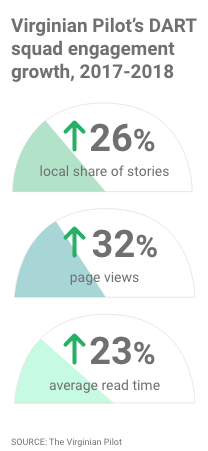From print-first to audience-first: Using analytics to change the newsroom mindset
For the past two years, the Virginian Pilot’s newsroom goals have not included a print component — a huge shift in its 154-year history.
“Our primary goal shifted from sustaining the print product to building a digital subscriber base,” said Senior Editor Jeff Reece, who’s been pushing the newsroom with other Pilot staff to evolve with changing reader habits.
But change is never easy and with it comes lots of questions. What does becoming a digital newsroom mean? How must the culture change? How does this fit into the newsroom’s mission?
The first step was to focus in on their digital audiences.
In 2016 that meant creating a digitally-focused reporting team called the DART squad — Digital Action in Real Time — that responds to breaking news and trending topics of the day. This team also tackles enterprise stories and “obsession beats,” the stories that don’t fall under any of The Pilot’s traditional beats, Reece said. Some of those have included stories on maritime port issues and child care regulations in Virginia.
Then they took a closer look at who their digital audience is, what they like reading and what to change about the Pilot’s journalism based on that data. Using Metrics for News, which they adopted in January 2017, the Pilot began to foster a culture of data-informed decision making. This has helped the newsroom rearrange priorities, and cut back on stories that are consistently low on both the paper’s mission and reader engagement to make time for more impactful journalism.
Nothing transformed overnight, of course. During this digital transition, Reece said he got plenty of pushback initially when it came to making editorial decisions based on data. People were concerned that using analytics to inform strategy would lead the newsroom further from its journalistic mission.
There was “fear that a lot of what we were going to do was concentrated at the top of the funnel,” he said, referring to digital audiences who don’t usually read the Pilot’s work. “…I think there’s a misnomer in the industry that the top of the funnel means shark stories, donut day stories. But they [audiences at the top of the funnel] are actually interested in enterprise stories, how tax dollars are being used. I think those stories do well throughout the funnel.”

As the newsroom sees the outcomes of some of these strategic initiatives, attitudes have slowly changed. The DART squad’s stories are consistently high on engagement and traffic, measured by Engagement Scores the Pilot created in Metrics for News. These scores blend several key metrics the newsroom cares about into a single number. For the DART squad, Engagement Scores over the last two years have on average performed between 11 to 22 percent higher than staff scores. The DART squad’s page views also increased 32 percent year-over-year from 2017 to 2018, average read time increased 23 percent, and the local share of stories read rose 26 percent, Reece said.
Additionally, creating custom Engagement Scores at the Pilot has allowed staff across the newsroom to see how their work contributes to growing a digital subscriber base. The score blends data like page views, reading time and social media engagement, and extra weight is given to local and loyal users’ engagement — which is the audience the newsroom wants to better serve and attract as paying subscribers. Using a blend of metrics customized to emphasize newsroom priorities, and making it accessible to all newsroom roles, has ensured that journalists would not be evaluated based on one data point alone.
The Pilot has also identified stories that haven’t been as impactful or engaging and reduced the amount of time they spend on those — in this case, public safety and government meeting stories. That has freed up time for reporters and editors to do more impactful enterprise work, such as this story on maternal mortality rates for black women in Virginia.
With all those changes, “in our newsroom, that distinction between being digitally oriented and a journalist is disappearing,” Reece said. “…We still have some editors and some reporters who hold onto things until they go to print. But in terms of how we make decisions on what we cover, I think they don’t think in terms of ‘this is digital and this isn’t,’ not as much as they used to at least. Everyone understands that we need to focus on digital.”
All that said, Reece notes that there’s still much work to be done in the journey toward a digital transformation. The newsroom is constantly learning, trying new things and adjusting along the way. Reece also continues to use Metrics for News on a regular basis to analyze the Pilot’s coverage and see what new lessons can be learned about the digital audience. And he’s hoping more reporters get comfortable using the tool on their own. But, considering the changes so far, the newsroom is well on its way.
Learn more
Find out whether Metrics for News might work for your news organization.
READ MORE FROM:Case studies & Resources
